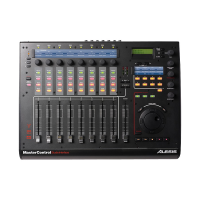AUD IN is a switch which enables/disables the VCA path to the Filter audio inputs. You of course do not
want a DC CV signal running into the filter audio inputs... And in the cases where you want to FM the
filters with Noise or the External Audio signal but not hear them filtered simultaneously, you turn AUD IN
to OFF.
It would be nice to have separate signal paths for each of these but there weren't enough pins on the
chips, space for the VCAs on the chips, and time to make it happen.
SO: It's a shared VCA.
Say I am in polyphonic mode and I turn on portamento, and I am using a sound with a
fast attack but a long release. If I hit note A first , and then note B, will the pitch of note A's long
release slide to the pitch of note B or will it continue playing at its original pitch until it fades?
In poly mode, all notes (voices) are independant. Each voice doesn't know what the other voice is
doing. So note (voice) A will glide to the key's pitch that launched the voice, regardless of whether
it's in the attack or release stages, and regardless of whether any other notes were played.
Is this user selectable from retain original pitch or follow the new note?
Not in poly mode.
The Dx-7 allowed both types of portamento in polyphonic mode. Most analogs
used the follow the new pitch method. I would dearly like an analog to have that unique sound of
the dx-7's retain the original pitch polyphonic portamento mode.
Which basicly sounds like a pitch envelope applied to each new note's attack, with the direction of
the pitch sliding determined by last note played. While each notes release stage retains its original
pitch.
If portamento start mode is set to "Last Key", each glide will start from the pitch of the last note, so it
looks like the A6 has what you want?
And it also has an exponential rate of slide.
As you've probably seen, you can select betweenthe usual 9 curves for the portamento glide.
2.27 another way to do unison-x:
Hold the chord button down and enter a chord by pressing one key at a time. Try pressing
the SAME key a few times. Voila, instant unison!
2.28 mike peake explains the unison x (unison detune) basics:
more question! <sigh> sorry dont mean to bombard ya or anything its just curiosity :) does andy
have unison detune function? is the unison programmable via 'unison/share' modes like Jupiter 6 /
Jupiter 8
It has a Unison X mode that allows as many voices to be layered on a single note as you want, in
both Mono and Poly modes. In Poly mode, there is a Unison X feature called Stack that defaults to
all 16 voices on one key and that then splits down the polyphony as you play more notes (16x1,
8x2, etc.). It's not as elegant as the MKS-80 modes but that's all they'd give us after multiple
requests. It's a shame that you can't toggle Stack separately after you've selected the number of
voices you want on a single note, so you wouldn't then have to be smashed by the full polyphony
upon every mono note.
In addition to that, there is a front-panel pot called Unison Detune that spreads the voices out in
tuning in a bipolar fashion centering upon the original pitch. It's sweet :)
2.29 mike peake explains chord mode:
What's the chord mode exactly?
It's where you can play a chord or any set of notes and the instrument will then allow you to play
them from a single note.

